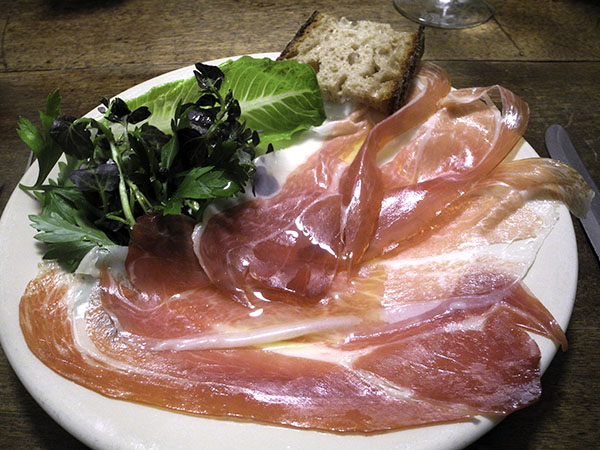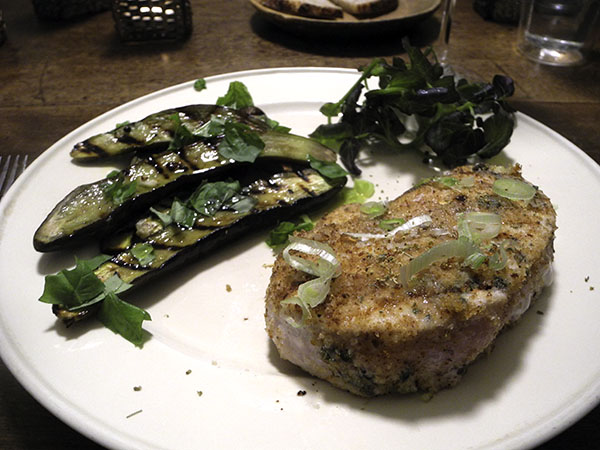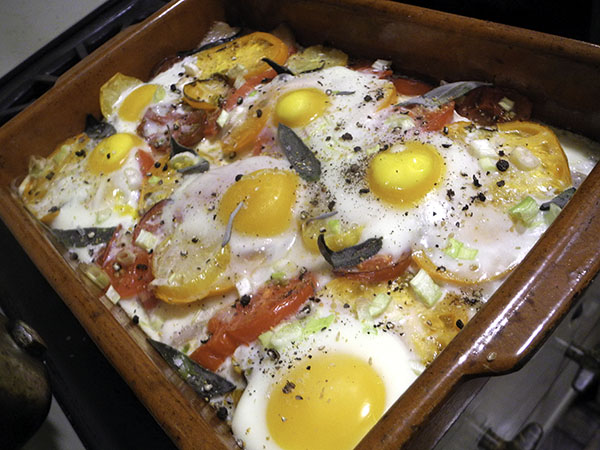
Colorful goodness.
- the fish serving began with a salsa prepared by heating 3 tablespoons of a Portuguese house olive oil from Whole Foods Market inside a small vintage Corning Pyrex Flameware blue-glass pot pot over a gentle flame, adding roughly 6 ounces of tomatoes (one sliced orange heirloom from Stokes Farm and a couple of sliced Mountain Magic tomatoes (‘cocktail tomato’ in size, “..a cross between a large-fruited tomato and a very sweet grape tomato…” a hybrid released in North Carolina sometime within the current decade) from Norwich Meadows Farm, along with 2 ounces or so of pitted whole kalamata olives from Whole Foods Market, the mix seasoned with sea salt and freshly-ground black pepper and stirred for a minute or 2 before the pan was set aside to cool a little, after which some 2 or 3 tablespoons of herbs (chopped fresh lovage from Quarton Farm, a Sullivan County grower new to the Union Square Greenmarket this year; an equal amount of fresh oregano buds from Norwich Meadows Farm; and torn leaves of a basil plant from Two Guys from Woodbridge) were stirred into the salsa, reserving some of the herbs to garnish the fish and salsa once it was on the plate, followed by the juice of half of an organic lemon from Whole Foods Market, the mix now stirred once again, and set aside while the fish was prepared
- four 4-ounce porgy fillets from P.E & D.D. Seafood, the skin slashed with a very sharp knife in 2 or 3 places on each, placed skin side down inside a large rectangular enameled cast iron pan in a tablespoon or so of olive oil that had gotten very hot sitting over a high flame, the top, or flesh side of the fish seasoned with sea salt and freshly-ground black pepper and cooked for 2 or 3 minutes until the flesh was dark golden and the skin crisp’, the fillets turned over, cooked on the other side for just about one minute, quickly basting with the oil in the pan during that time, or until the fillets were just cooked through, arranged on the plates, the salsa drizzled around the porgy and both sprinkled with some of the reserved herbs

- ten ounces or so of tiny purple okra from Lani’s Farm, sautéed over a high flame inside a large enameled cast iron pan in a little bit of olive oil [supposedly cast iron causes even green pods to blacken, but I’ve never really noticed that, at least not as a problem, these pods were already a dark purple going in, but I went with an enameled pan nevertheless], adding a good part of one crushed dried peperoncino Calabresi secchi from Buon Italia half way through, seasoned with sea salt
- the wine was an Oregon (Columbia Valley) white, Dave Harvey Columbia Valley Sauvignon Blanc 2017, from Naked Wines
- the music was Handel’s 1738 opera, ‘Faramondo’, a story of the eponymous late 4th, early 5th-century Frankish dux and goings on in the ancient geographical home of my own family (“All ends happily with general rejoicing…”), performed by I Barocchisti, conducted by Diego Fasolis [a 6-minute excerpt from that same performance here]


















